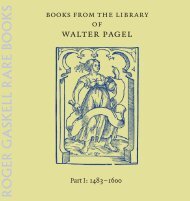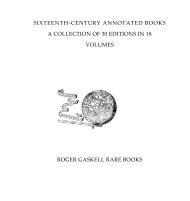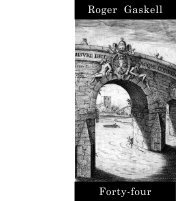pdf - Roger Gaskell Rare Books
pdf - Roger Gaskell Rare Books
pdf - Roger Gaskell Rare Books
You also want an ePaper? Increase the reach of your titles
YUMPU automatically turns print PDFs into web optimized ePapers that Google loves.
First published as The surgions Mate in 1617, this was the Wrst textbook written<br />
for naval surgeons and has been called ‘the Wrst good medical textbook of<br />
its kind in English’ (ODNB). It is famous for Woodall’s early advocacy of<br />
the use of lemons and limes to prevent scurvy.<br />
Woodall’s other writings are included in this<br />
second edition which is the Wrst collected edition<br />
of his works. The work reXects Woodall’s support<br />
of Paracelsian chemistry and chemical medicines.<br />
There is also a section on alchemy (expanded<br />
from the Wrst edition) and an essay entitled<br />
‘Certain fragments concerning chirurgerie and<br />
alchymie,’ published in this edition for the Wrst<br />
time with a table of alchemical symbols and a<br />
glossary of alchemical terms (Debus, The English<br />
Paracelsians pp. 99–101).<br />
One of the most prominent surgeons of his<br />
generation, Woodall played a leading role in the<br />
Company of BarberSurgeons, becoming master<br />
in 1632. He was involved in the building of the<br />
company’s anatomy theatre, designed by Inigo<br />
Jones and modelled on the anatomy theatre<br />
at Padua. In 1613 he was appointed the Wrst<br />
surgeongeneral of the East India Company.<br />
‘The instruments and medicines for a<br />
surgeon’s chest, with their uses, are clearly described, followed by sections<br />
on acute surgical problems, potentially lethal medical conditions, a discourse<br />
on scurvy, and a treatise about alchemy and chemical medicines. Woodall’s is<br />
also the earliest comprehensive clinical account of scurvy to prescribe lemon<br />
juice for its prevention and cure. Between 1626 and 1628 the BarberSurgeons<br />
were authorized to supply surgeons’ chests for the navy, merchant marine, and<br />
the army, which prompted Woodall to publish in 1628 his Viaticum, the Path-<br />
Way to the Surgeons Chest; specializing in the treatment of gunshot wounds it<br />
was mainly designed to instruct young surgeons with the English troops who<br />
attempted to relieve Huguenots blockaded in the Atlantic port of La Rochelle.<br />
This short work and Woodall’s Treatise... of... the Plague and a Treatise of<br />
Gangrene and Sphacelos were incorporated with separate titlepages in a revised<br />
and extended edition of The Surgions Mate... in 1639. Dedicated to Charles I,<br />
it contains an equestrian portrait of the king engraved by William Marshall and<br />
a Wne plate illustrating Woodall’s own invented hand trephine, safely used for<br />
cutting holes in skulls for the next three centuries. His detailed description of<br />
the amputation of sphacelos, or dead tissue, at the upper limit of established<br />
gangrene, enabling him to save more than a hundred lives, was long accepted<br />
as a standard work on the subject.’ (John H. Appleby in ODNB.)<br />
Bibliographical note. Signature G contains 8 leaves: G1,2 signed; G3 unsigned;<br />
G4,5 signed G3,2; G6–8 unsigned. It is not clear from this copy which<br />
leaves are conjugate. The contents of these leaves are as follows: G1–2, pp.<br />
23–26; G3r–v, verses, ‘To his very worthy and entirely respected friend and<br />
Brother’; G4r–G6r ‘Enema fumosum, or a Fumous Glister’; G6v blank;<br />
G7r–8r pp. 27–29; G8v blank. In most copies the unsigned leaf containing the







